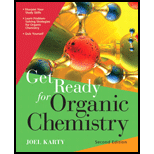
Concept explainers
Interpretation:
The two chair conformations of
Concept introduction:
Cyclohexane exists in two chair conformations which interconvert through a chair flip. The hydrogen atoms in cyclohexane are either in axial or equatorial positions. During chair flip, the hydrogens that were in an axial position are in the equatorial position and vice versa. However, the two chair conformers of cyclohexane are indistinguishable as all atoms bonded to the ring carbons are small hydrogen atoms.
In substituted cyclohexane, the larger size of the substituent atom or group reduces the stability of one of the conformations. Bulky groups require more space than hydrogen atoms and, therefore, are more stable in the equatorial position. A substituent in axial position is close to the two hydrogen atoms in axial positions on the same side of the ring. There are no such hydrogens in close proximity to a substituent in an equatorial position. This makes the equatorial conformer more stable.
Want to see the full answer?
Check out a sample textbook solution
Chapter 4 Solutions
Get Ready for Organic Chemistry
- Consider the molecule 1-bromo-2-methylbutane. C3 and C4 should be drawn as Et as in theexample. This group is called an ethyl group and can be considered a sphere about twice the sizeof a methyl group. Draw the following Newman projections sighting down the C1C2 bond... a. The lowest potential energy conformation. b. The highest potential energy staggered conformation.arrow_forwardDetermine how many Gauche interactions are in the most stable chair conformation for each of the following structures.arrow_forwardDraw the most stable conformation of the molecule shown below. The most stable conformation is the one in whicharrow_forward
- Considering rotation around the bond highlighted in red in eachcompound, draw Newman projections for the most stable and leaststable conformations. (See Attached file)arrow_forward(iii) Draw the lowest energy conformer for the following compound.arrow_forwardWhich of the conformations has a lower energy?arrow_forward
- Draw Newman projects of all the staggered conformations for the molecule below looking along the bolded bond in the direction indicated by the arrow. The carbon closest to the arrow should be the front carbon of your Newman projection. (It is a practice problem from the book but I am confused about how to approach it.)arrow_forwardDraw the lowest energy Newman projection of the molecule on the left looking down the bond indicated for molecule A. For molecules B and C, draw the lowest energy chair conformations.arrow_forwarda) Sighting along its C-N bond, draw the Newman projection of the conformation of dimethylamine given in perspective below. (Note the presence of the lone pair of electrons on the nitrogen.) H H C-N H CH3arrow_forward
- Problem: Perform a conformational analysis 2-iodo-2-methylbutane, looking down the C2—C3 bond. Pay attention to the relative energies of the various conformations, but do not concern yourself with the actual energy values. Pleae draw newman projections.arrow_forwardProblem: Perform a conformational analysis 2-iodo-2-methylbutane, looking down the C2-C3 bond. Pay attention to the relative energies of the various conformations, but do not concern yourself with the actual energy values.arrow_forwardDraw 1-methyl-3-isopropylcyclohexane in its most stable conformation. Hint: Please note that the most stable conformation of cychohexane is NOT a planar hexagonarrow_forward
 Organic Chemistry: A Guided InquiryChemistryISBN:9780618974122Author:Andrei StraumanisPublisher:Cengage Learning
Organic Chemistry: A Guided InquiryChemistryISBN:9780618974122Author:Andrei StraumanisPublisher:Cengage Learning
